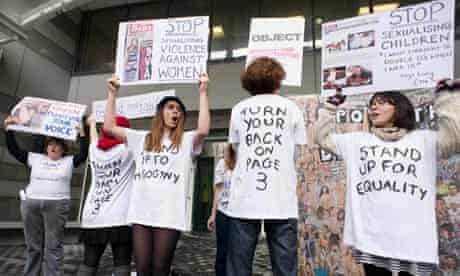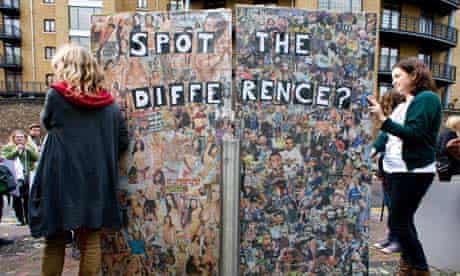Sexist Speaker Women Submissive Man Family Protest Campus
Just over a week ago, a group of campaigners gathered outside the News International offices in east London with a birthday bill of fare for the Sun.
The occasion? The 42nd anniversary of Page 3. The card was 6ft loftier, and while one side showed how women are portrayed in some of the tabloids – topless images from the Sun and the Star, likewise as semi-naked, bent-double images from the Sport — the other showed how men are portrayed. The crucial divergence could exist summarised in the single give-and-take "apparel"; more broadly, men were pictured as active, respected professionals. The protesters wrote their feelings nearly Page three in the card. "A woman is worth more than than her loving cup size," scrawled one. "Withal stuck in the sexist, Savile-loving 70s, Dominic?" asked some other.
That concluding message refers to Sun editor Dominic Mohan, who in February this year defended Page iii equally an "innocuous British institution" while giving evidence to the Leveson inquiry. The campaigners tried to enter the Sun offices to deliver the card to him directly, just security guards called the police – who turned up, and promptly signed the No More than Page iii petition, adding the message: "Women deserve respect from the media." The petition doesn't call for a ban, just asks Mohan to kindly remove the classic Page 3 epitome, and has gathered near sixty,000 signatures in the three months since it launched.
When the protesters put a photograph of the altogether card up on Facebook, it was taken downwardly, without alarm, because the explicit images evidently violate Facebook's terms; similar cloth was presented to the Leveson inquiry in January, when information technology was also censored. "If simply it was that easy to get rid of sexism within our press," sighs Anna van Heeswijk, CEO of Object, which led the protest along with campaign groups Turn Your Back on Folio Three and No More Page Three.
The Facebook and Leveson censorship should be surprising because, equally Van Heeswijk says, "these are images that are independent within our national newspapers, completely available to all, mainstream, unrestricted, sold in newsagents and supermarkets."
The Page three protest is but one of an extraordinary number of current campaigns against media sexism. Over the past few years, and particularly the by few months, acrimony about the media portrayal of women, in terms of visibility, sexualisation and humiliation, has grown at feverish step. Along with the campaigns to end Page 3 are projects to highlight the paucity of female experts in broadcasting and the dearth of older women on Television, to make information technology easier for journalists to find female speakers, to show how media sexism affects women on a personal level, and clarify but how it feeds into a civilisation in which women's conviction is undermined, ambitions narrowed, and experiences of rape and violence disbelieved. At that place's a growing sense this could be a watershed moment, when coverage genuinely changes for the better.
The iv groups behind the report Just the Women certainly hope and then. (Their title is, of course, a reference to the now-notorious comment from Newsnight editor Peter Rippon that the show's Jimmy Savile investigation needed more work, since the sources were "just the women".) Eaves, End Violence Against Women (Evaw), Equality Now and Object all presented bear witness to Lord Justice Leveson this year, and he reports back on Thursday. To sharpen and renew the focus on these issues they have carried out an evaluation of the press, charting examples of sexism.
What was almost surprising, says Julia Hilliard, a feminist activist and volunteer at Eaves, was the sheer volume of sexist content. In 11 national newspapers, over two weeks, they found more than than 1,300 examples. "It's piece of cake to laugh off or dismiss private examples as, 'You're reading too much into information technology, information technology's a joke'," she says. "But cumulatively, information technology'due south a barrage." Analysing the material "felt like beingness insulted constantly, just being belittled and degraded and put in your place".
Another researcher, Roxanne Halsey, says the experience demonstrated very conspicuously to her how sexist media affects women. The mocking coverage of female politicians, for case, knocked her confidence, and left her feeling that: "This is what happens to women who are prepared to be in the public heart – you get insulted past both men and women." She volunteers at Eaves twice a week, and wouldn't have wanted to work on the project more than that. "Of course, you lot can imagine what it's similar looking at photos of women's breasts for days … but that doesn't modify the fact that you lot await at these photos, and you offset thinking nearly your own torso." Existence able to analyse the material from a feminist perspective didn't neutralise its effects, she says.

The report pinpoints a number of problem areas. One is the trend to sexualise immature girls, while purporting to condemn this; in the two-week period, a child beauty pageant was covered enthusiastically by many of the tabloids, which ran numerous photographs aslope critical articles. For instance, the Sun ran a piece with pictures and the subheading "CAVORTING provocatively in a tiny pink swimsuit and clutching a cuddly stuffed kitten, little Ocean Orrey struts her stuff in a British beauty pageant – aged just 4."
When reporting crimes against women, there was a tendency to trivialise the event, and to sympathize with the perpetrator, "past eulogising their achievements, and highlighting their careers, their celebrity, and their supposed respectability". In coverage of female person politicians, at that place was a tendency to mock them. And, of course, in that location are all those images highlighted by the Page iii protest.
The report mentions the 16 September encompass of the Sunday Sport, for instance, in which a film of a adult female's bottom ran abreast the headline "Katy Perry Upskirt Photo Shock". This isn't especially unusual for the Sport. Its wednesday edition launched last year with a front page shut-up of a adult female's crotch, above the headline "Cheryl Cole Upskirt Moving-picture show Shock" and last calendar week Tv presenter Holly Willoughby complained to the Press Complaints Commission over a fake upskirt photo of her in the Dominicus edition. Her complaint was addressed with a front-page amends this week, which admitted: "Contrary to the clear impression that we give in the edition, no part of the 'upskirt' photograph was of Holly Willoughby." This apology ran above images of a immature Coronation Street player in a bikini – the main encompass pic showing her bent over, from behind.
It's often unclear whether upskirt shots are staged or real, consensual or not. But whatever the circumstances, these shots "make the link between the sexualisation in the papers and violence against women really clear," says Holly Dustin, managing director of Evaw, because "the implication, either way, is that information technology'due south non-consensual, and that information technology's sexual exploitation being presented for our entertainment."
Interestingly, cover poses similar to those seen in the Sport take recently become quite mainstream. On the Nov encompass of Esquire, Cameron Diaz appeared bent over in her pants, while the Dec issue of Tatler shows a model fully clothed, but bottom aloft, pulling upwardly her dress. Would a powerful male person player ever be asked, or concur, to pose in his pants, bent over, on the encompass of a mainstream publication?
Arguments have long been made confronting the idea that media sexism genuinely affects how we view and treat women, only over the past yr, diverse sources have disputed this. In January, for instance, Alison Saunders, caput of the Crown Prosecution Service in London, suggested the media portrayal of immature women could touch on juries in rape trials. "If a girl goes out and gets boozer and falls over," she said, "they are almost demonised in the media, and if they so get a victim, y'all can run into how juries would bring their preconceptions to deport."
Not long after, a survey of ane,600 women, conducted by website Mumsnet, plant one in 10 had been raped, four-fifths of those who had been assaulted hadn't reported information technology, and lxx% felt the media were unsympathetic to women who report rape – considerably more than the 53% who felt the legal organization lacked sympathy. Then there's the Savile scandal. Since the stories of his crimes began being reported, rape helplines take seen an enormous rise in calls, which shows what happens when victims of sexual violence are believed and taken seriously. This raises the obvious question: what happens when, as is more usually the case, they're not?

A new website, Everyday Media Sexism, also allows women to recount their showtime-person experiences – it follows and builds on the success of the website Everyday Sexism started by writer and women's activist Laura Bates earlier this year. The site includes a submission from a woman who recalls sitting on a bus, aged 14, in her school uniform, aslope a center-anile human who was looking at Page iii. He turned to her breast, and remarked: "I wouldn't worry – with tits like yours, they're not going to ask you to pose."
Information technology's sobering to think that the most prominent image of a woman in our papers each day is of a teenager or twentysomething in her pants; the Sunday does, afterward all, have the highest apportionment of any British newspaper, and Page 3 is its most famous feature.
Information technology would assistance if there were at to the lowest degree more positive images of women, and more women's voices, to balance this out. Only as numerous projects have shown, this is far from the example. A Women in Journalism report last month, for example, which I was involved in, found women write but 22% of front-page articles, and account for just 16% of those mentioned or quoted in atomic number 82 stories. An analysis of the starting time person mentioned in each front-page pb story institute three-quarters of the expert voices were men, and 79% of victim's voices were women. When information technology came to the ten people pictured most frequently on our front pages in the specific month nosotros looked at, iii were female – the Duchess of Cambridge, a adult female divers by her marriage; Pippa Middleton, a woman divers by her sister's marriage; and Madeleine McCann, the young victim of an abduction. By comparison, the men pictured virtually frequently on the front pages were known primarily for professional person reasons.
Lis Howell, managing director of dissemination at City University, has been working on the Skillful Women campaign, in conjunction with Circulate mag, since last February; she and her students take been monitoring the proportion of women used as experts on various TV and radio programmes since 2009. BBC News at 10 recorded its worst ever score on Thursday 25 October, when it featured 13 male person experts and 1 female expert. As part of the entrada, the magazine has created a pledge for broadcasters, asking them to aim for 30% of on-air experts to be women; Sky News and Channel 4 take signed up, but the BBC refused.
What's interesting, says Howell, is that while people often argue that "women get a raw deal in television set because appearance is then of import, in that example why aren't there more than women on radio? Radio is actually overall worse and more sexist." The Today programme is especially bad, she says, which became clear earlier this month when, on sequent days, it featured a conversation amidst male experts almost teenage contraception, and then three men talking about chest cancer.

Those incidents inspired feminist writer Caroline Criado-Perez and Catherine Smith to set the website thewomensroom.org.uk, a database of female experts. In simply three weeks, more than 1,000 women have signed upwards, which contradicts the notion that women aren't interested in public speaking. Similarly, a contempo preparation course for potential female person broadcasters, organised by the BBC, had more than 500 applicants for 33 places.
Of course, media sexism ofttimes intersects with other forms of discrimination. The Just the Women report points out that tabloid images of women are "overwhelmingly white, immature, able-bodied and sparse", then notes, depressingly, that ane place where "images of older and blackness and minority ethnic (BME) women were found was within the pages of adverts for the sexual activity manufacture contained within some of these publications".
Last year Chitra Nagarajan, a fellow member of the activist group Black Feminists, started the influential "diverseness audit" hashtag on Twitter, for people to log male person or female representation, as well as the representation of other groups. And Miriam O'Reilly – who was dropped from the Tv set bear witness Countryfile in 2009, and went on to win an ageism claim against the BBC – has been working tirelessly to meliorate the media representation of older women. She is currently working on a Labour committee on the portrayal of older women in the media and public life, and feels the issue is "really in the public consciousness now. I've had older women run after me in the street and put their arms around me, and say they experience we're overlooked."
She'south hoping the committee will prompt genuine modify, and says Labour hasn't ruled out legislation on the issue. Criado-Perez hopes to brand The Women's Room a site where women can network too, and Howell says the Expert Women entrada will continue until "the day the Today plan has reached, consistently, at least iii to one women experts." Given that only around 18.5% of its reporters and guests are currently women, it could be some time.
The groups behind Simply the Women take spelled out the changes they are hoping to see as well. For instance, under any new press regulatory body, they would like it to be possible to brand third-party complaints, besides as thematic complaints – and then if an result such as rape or domestic violence is regularly covered in a problematic way, that could be addressed. They besides debate that sexually explicit images, which aren't allowed on Television receiver before the 9pm watershed, and aren't allowed in the workplace under equality legislation, should not be printed "in national newspapers which are not age-restricted and are displayed at child's centre level".
On Thursday they will see if those and other suggestions are successful.
But any Leveson decides, it seems unlikely women volition stop protesting about media sexism, much of which looks peculiarly anachronistic in the wake of the Savile revelations. Every bit Van Heeswijk points out: "Page iii was launched in 1970, when in that location was no equality legislation, sexual harassment wasn't recognised in police force, and rape in marriage was legal. It's at present 2012. Isn't it time we got rid of this form of sexism from our press?"
Source: https://www.theguardian.com/media/2012/nov/27/women-fighting-sexism-media-page-3
Belum ada Komentar untuk "Sexist Speaker Women Submissive Man Family Protest Campus"
Posting Komentar